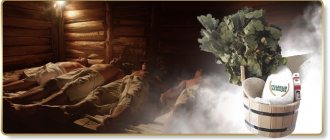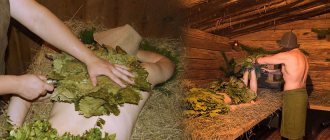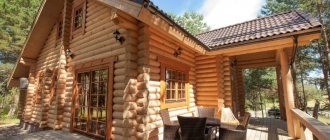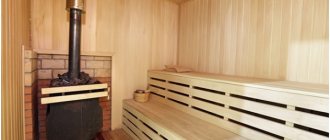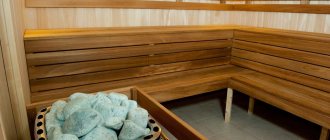Russian bathhouse in black style The bathhouse has always been and is for Russian people not just a place where you can take hygiene procedures and cleanse your body of impurities, but a special, almost sacred structure, where cleansing occurs not only on the physical, but also on the spiritual level. It’s not without reason that those who visited the bathhouse, describing their own feelings, say:
How he was born again, became 10 years younger and cleansed his body and soul.
The concept of a Russian bath, the history of its appearance
A Russian bathhouse is a specially equipped room that is designed for water hygiene and thermal procedures for the purpose of prevention and healing of the entire body.
Today it is difficult to judge what prompted ancient man to think about creating a bathhouse. Perhaps these were random drops that fell on a hot fireplace and created small clouds of steam. Perhaps this discovery was made intentionally, and the person immediately appreciated the power of steam. But the fact that the culture of steam baths has been known to mankind for a very long time is confirmed by numerous archaeological excavations and written sources.
Thus, according to the ancient Greek chronicler Herodotus, the first bathhouse appeared in the era of tribal communities. And having visited back in the 5th century. BC. the territory of the tribes inhabiting the Northern Black Sea region, he described in detail the bathhouse, which resembled a hut-hut, with a vat installed in it, into which red-hot stones were thrown.
Approximate material calculation
To carry out the calculation, you need to take into account what diameter the log will have. A larger one is better for a bath, but it is more expensive. The optimal diameter is 280 mm. The cost of 1 m3 of such logs with cups is on average about 8 thousand rubles.
Now you need to determine the height of the pediment. To do this, it is recommended to focus on natural conditions. In case of a large amount of precipitation, the gable should be high and the roof steep so that the snow does not linger on it, and in strong winds, vice versa, so as not to create excessive windage. The average height of the pediment is 1.5 m.
Photo gallery: drawings of a log house and necessary parameters
Top view and log cross-section parameters
A drawing of a log house will help in filling out the initial data
To calculate the amount of material, you must fill in all the initial data
A special calculator can help with the calculation.
All values can be entered into a special table
Unwashed Europe and clean Russia
Later sources indicate that bath culture also existed in Ancient Rome, whose rulers spread it to the conquered territories of Western Europe. However, after the fall of the Roman Empire, both the bathhouse and ablution as such were forgotten in Western Europe. There was a ban on bath culture, which was explained, among other things, by widespread deforestation and, as a consequence, a shortage of firewood. After all, in order to build a good bathhouse and heat it well, it is necessary to cut down a lot of trees. Medieval Catholic ethics also played a certain role, which taught that nudity of the body, even for washing, was sinful.
The decline in hygienic requirements led to the fact that Europe for many centuries was mired not only in its own sewage, but also in diseases. Monstrous epidemics of cholera and plague only for the period from 1347 to 1350. killed more than 25,000,000 Europeans!
Bath culture in Western European countries was completely forgotten, as evidenced by numerous written sources. Thus, according to Queen Isabella of Castile of Spain, she washed herself only twice in her life: when she was born and when she got married. An equally sad fate befell King Philip II of Spain, who died in terrible agony, consumed by scabies and gout. Scabies finally tormented and brought Pope Clement VII to the grave, while his predecessor Clement V died of dysentery, which he contracted because he never washed his hands. It is no coincidence, by the way, that dysentery began to be called “the disease of dirty hands” already in the 19th and 20th centuries .
Around the same period, Russian ambassadors regularly reported to Moscow that the king of France stank unbearably, and one of the French princesses was simply eaten by lice, which the Catholic Church called God's pearls, thereby justifying their senseless ban on baths and the culture of basic hygiene procedures.
No less curious and at the same time repulsive are the archaeological finds of medieval Europe, which today can be seen in museums around the world. Eloquently testifying to the widespread filth, stench and uncleanliness, exhibits are on display for visitors - scratchers, flea traps and saucers for crushing fleas, which were placed directly on the dining table.
Flea catcher - devices for catching and neutralizing fleas; in the old days an essential element of the wardrobe
Today it has already been proven that French perfumers invented perfumes not in order to smell better, but in order to simply hide the smell of a body unwashed for years under the fragrance of floral aromas.
Blokholovka
And all that remains is to sympathize with the daughter of Grand Duke Yaroslav the Wise , Anna , who, after marrying the French King Henry I , wrote to her father at home, saying:
Why did I anger you so much, and why do you hate me so much that you sent me to this dirty France, where I can’t even really wash myself?!
Rules for taking a bath and preparing for it
For the bath to be beneficial, it is enough to follow a few basic rules:
- Do not drink alcohol both while in the steam room and before visiting it;
- Don’t overeat (you shouldn’t go hungry either, you can get by with a light snack);
- Monitor your condition and do not force yourself to sit in the steam room;
- You can enter the steam room several times, each entry will differ from the other in thermal conditions and duration;
- You should stay in the bathhouse for no more than 25 minutes.
Before visiting you must:
- Douse yourself with warm water or take a shower to prepare your body for higher temperatures.
- To preserve the lipid layer of the skin, which performs a barrier function, you need to refrain from using soap with a washcloth.
- Do not get your hair wet, this will protect you from heat stroke. It is better to put on a hat made of wool or linen, after wetting it.
But what about Rus'?
And in Russia, the bathhouse has always existed , at least according to the Byzantine historian Procopius of Caesarea , who back in the 500s. wrote that the culture of ablution accompanies the ancient Slavs throughout their lives.
According to ancient descriptions, the bathhouse was a log structure with a fireplace, on the hot coals of which water was poured from time to time, which turned into steam. According to popular beliefs, the guardian of the bathhouse and its soul is the bannik - a completely naked old man, whose body is covered with broom leaves. Bannik was supposed to be cajoled from time to time by treating him to bread and salt, which once again emphasizes the respectful attitude of the Slavs towards the bathhouse itself and its “essence”, which they literally idolized.
Appearing on the territory of Russia back in the days of paganism, when people worshiped the cult of fire and water, both the bathhouse and the home were deeply revered by the Slavs, as noted in their works by researchers of Russian life I. Zabelin and A. Afanasyev . The bathhouse was not just a place where one could cleanse one’s body of dirt and take hygienic procedures, but also a kind of medical and preventive institution where people of the ancient medical specialty could put any sick person back on his feet.
In turn, the chronicles of the X–XIII centuries. indicate the widespread use of the bathhouse among the Eastern Slavs, starting from the 5th–6th centuries, when it was affectionately called movnitsa, mov, mylnya and vlaznya. And even with the baptism of Rus', when the church began an active struggle against folk healers and all sorts of superstitions, the bathhouse did not cease to exist, but only strengthened its influence, as it became a place for mandatory visiting before performing the most important church rituals - baptism, wedding, communion and others .
Approval of the project by administrative authorities
This is a key step. Without approval of the project before the start of construction, an already built bathhouse can be demolished due to any complaints from neighbors, and you will lose the labor and money invested. The project should include the following items:
- A plan (floor plan, even if you have only one), created according to all the rules of drawing with specifications, sections and explication.
- Approximate estimate for materials.
- Planned type of foundation with drawing.
- Consent of the closest neighbors for construction.
The bathhouse design must be agreed upon with the necessary authorities
“Heat my bathhouse in white!”
The white bathhouse, which V. Vysotsky sings about in his song, appeared in Rus' much later than the black bathhouse, gradually displacing the latter. At first, the Slavs built baths without a chimney, in black style, and a periodically opening door was used as natural ventilation. In a black-style sauna, smoke does not go into the chimney, but into the sauna room itself, from where it exits through an open door, as well as through a special hole in the ceiling or wall (the so-called “pipe”). After the firebox is finished and the coals have completely burned out, the door is closed, the chimney is plugged, and the shelves, benches and floor are washed generously with water to remove soot and the bath is kept for about 15 minutes before use so that it dries and gains heat. Then the remaining coals are raked out, and the first steam is released so that it carries away the soot from the stones. After that you can steam. A black sauna is more difficult to heat and cannot be heated during washing (like a white sauna), but due to the fact that the smoke eats up all the previous odors, a black sauna has its own charm, unattainable in a white sauna.
Later they began to build white baths, where the source of heat and steam was a stove-heater with a chimney.
Vasily Shevchuk. "Russian baths in black style"
In addition, at that time there was another interesting and unusual way to steam directly in a Russian oven. To do this, it was carefully heated and the bottom was covered with straw. Then a person climbed inside the oven, taking with him water, beer or kvass, which he poured over the hot walls of the hearth and took a steam bath, after which he came out and doused himself with cold water. Even the weak and old people did not deny themselves such an unusual pleasure, they were simply pushed into the oven on a special board, and then a healthy person climbed in to wash and steam the weak one, as expected.
How to build a sauna stove
For all sauna stoves there is a single condition, the fulfillment of which is mandatory - lengthening the combustion channel so that the door is located in the dressing room (firewood is placed in it in that room).
The oven door must be in the dressing room
You can install a metal stove by purchasing it ready-made, or build a brick one yourself (it is much better due to its slower heating and long-term heat transfer). The most difficult thing will be to correctly remove the chimney through a wooden roof, insulating it with special metal sheets and vermiculite.
When installing a stove, the most difficult thing is the chimney outlet
Stones must be selected as carefully as possible. They must have the following qualities:
- heat resistance (does not collapse due to temperature changes);
- heat capacity (gives off heat for a long time);
- environmental friendliness (does not emit harmful substances when heated);
- homogeneity and the same coefficient of thermal expansion (foreign inclusions with a different thermal expansion can explode when heated);
- round shape (it improves the circulation of hot air).
The stones should be:
- up to 13 cm for the first layer on the grill;
- up to 9 for the intermediate layer;
- up to 6 for the top layer.
Bath stones should be round in shape
If the heater is made correctly, then unforgettable moments of steam await you.
Russian traditional steam room with heater can be supplemented with dry herbs for aroma
A bathhouse for a Russian is more than love!
The bathhouse accompanied every Russian person from birth to death. In no other culture in the world has it become as widespread as in Rus', where visiting it was elevated to an obligatory cult and had to occur regularly.
Not a single celebration could take place without it, and when meeting even a random guest, the owner first of all invited him to visit the bathhouse, and then taste the treat and spend the night. It is no coincidence that in Russian fairy tales, in addition to shelter and dinner, travelers are always offered a bathhouse.
Hen and stag parties, as they would say today, necessarily ended with a visit to the bathhouse, and the young people themselves, having become spouses, were obliged to take it regularly, every time after marital intimacy, if they went to church the next morning. It was necessary to go to the bathhouse with almost any ailment, especially if it was a cold, runny nose, cough and joint diseases.
The therapeutic effect of this simple and pleasant procedure is comparable to the strongest effect on the entire human body. When every cell of the body receives an unimaginable charge of energy, forcing it to work in a new way, thereby restarting the natural processes of regeneration and self-renewal. And alternating high temperatures with cold, when after visiting the bathhouse it is customary to jump into the snow, an ice hole, into a river, or simply douse yourself with ice water - this is the best way to harden and strengthen the immune system.
As for the special love of Russians for the bathhouse, it is embodied not only in folklore, but also reflected in historical documents. Thus, the Russian historian and researcher of the customs and life of the Russian people N.I. Kostomarov repeatedly notes in his works that people went to the bathhouse very often in order to wash themselves, heal, and just for fun. According to him, for a Russian person, visiting a bathhouse is a natural need and a kind of ritual, which neither adults, nor children, nor the rich nor the poor can violate.
In turn, foreigners who visited Rus' were surprised to note the habit of the Russian people to wash themselves very often and for a long time, which they had not encountered either in their homeland or in other countries. In fact, as a rule, we washed once a week, on Saturdays. But for foreigners who almost never washed, it seemed “very often.” For example, the German traveler Adam Olearius once wrote that in Russia it is impossible to find a single city or even a poor village where there is no bathhouse. They are simply here at every turn, and they are visited at every opportunity, especially during periods of ill health. And as if to summarize, in his writings he noted that perhaps such a love for the bathhouse is not without practical meaning, and that is why the Russian people themselves are so strong in spirit and healthy.
As for Europe, for the revival of the custom of steaming and washing regularly, it should be grateful to Peter I and the Russian soldiers, who, terrifying the same French and Dutch, steamed in a hastily built bathhouse, and then jumped into the icy water, despite to the frost that reigned outside. And the order given in 1718 by Peter I to build a bathhouse on the banks of the Seine completely horrified Parisians, and the construction process itself attracted onlookers from all corners of Paris.
What tool will you need?
To build a bathhouse with your own hands you need:
- electric saw;
- grinder with a set of discs;
- drill with various drills and grinding attachments;
- planer, jointer (or electric analogues);
- axes;
- crowbar, mount;
- pliers, nail puller;
- bayonet and shovel;
- hydraulic level;
- hammers;
- mallet;
- bit;
- set of chisels;
- files;
- caulk tool;
- tape measure and carpenter's meter;
- buckets;
- wheelbarrow;
- stairs;
- construction trestles;
- container for concrete or construction mixer.
Now you can proceed directly to construction.
